The Impact of Rainfall on Soil Moisture Variability in Four Homogeneous Rainfall Zones of India during Strong, Weak, and Normal Indian Summer Monsoons
Abstract
:1. Introduction
2. Data and Methods
2.1. Daily Rainfall Data and ESA CCI Daily SM Combined Product
2.2. Definition of the Strength of ISMs over the IMD Regions
2.3. Summary of Methods
3. Results
3.1. Distinctive Features of SM between Strong and Weak ISMs
3.1.1. Spatial Distribution of Indian SM and Rainfall
3.1.2. Temporal Distribution of Indian SM and Rainfall
3.2. SM Dependence on Rainfall Associated with the Strength of ISMs
3.2.1. Spatial Distribution of Correlation between Daily SM and Daily Rainfall
3.2.2. Explained Variance of Daily SM by Daily Rainfall
3.2.3. Spatial Variations in Response of Daily SM to Daily Rainfall
3.2.4. Persistence in Daily SM
4. Discussion
5. Conclusions
- (1)
- Monthly and seasonally mean SM values in NWI, CI, and SPIN at the same locations are generally higher during strong ISMs than during weak ISMs. The regional distinct SM features between the IMD regions are not only associated with the strength of rainfall, but presumably associated with other factors, such as local soil and vegetable types and environmental conditions (winds, surface and air temperature, air water vapor, etc.) which influence the capability of holding the SM values locally. Nevertheless, the distinct SM features at the same location between the different strengths of ISMs are associated with daily rainfall magnitude and its short-term fluctuations.
- (2)
- The daily SM and its dependence on daily rainfall appear to be region-locked in space and phase-locked in time: Strong correlation and large response generally occur in most parts of SPIN and NWI during June (June–July) of strong (weak) ISMs where SM values are relatively small; Weak correlation and weak response generally occur in CI and NEI in July-September (August–September) of strong (weak) ISMs where SM values are relatively large. The region-locked feature is presumably associated with the local soil and vegetation types and/or environmental conditions. The phase-locked feature is associated with the features of ISMs.
- (3)
- Daily SM persistence in each IMD region is not only controlled by the strength of ISMs and short-term rainfall fluctuations in each IMD region, but is strongly associated with previous SM values, which are presumably tied with the local features, such as soil and vegetation types and/or environmental conditions.
Author Contributions
Funding
Data Availability Statement
Acknowledgments
Conflicts of Interest
References
- Kerr, J.M. Sustainable Development of Rainfed Agriculture in India (No. 20); International Food Policy Research Institute (IFPRI): New Delhi, India, 1996. [Google Scholar]
- Wuttichai, G.; Kosittrakun, M.; Righetti, T.L.; Weerathaworn, P.; Prabpan, M. Normalized difference vegetation index relationships with rainfall patterns and yield in small plantings of rainfed sugarcane. AJCS 2011, 5, 1845–1851. [Google Scholar]
- Dutta, D.; Kundu, A.; Patel, N.R.; Saha, S.K.; Siddiqui, A.R. Assessment of agricultural drought in Rajasthan (India) using remote sensing derived Vegetation Condition Index (VCI) and Standardized Precipitation Index (SPI). Egypt. J. Remote Sens. Space Sci. 2015, 18, 53–63. [Google Scholar] [CrossRef]
- Guhathakurta, P. Drought in districts of India during the recent all India normal monsoon years and its probability of occurrence. Mausam 2003, 54, 542–545. [Google Scholar] [CrossRef]
- Robock, A.; Vinnikov, K.Y.; Srinivasan, G.; Entin, K.; Hollinger, S.E.; Speranskaya, N.A.; Liu, S.; Namkhai, A. The global soil moisture data bank. Bull. Am. Meteor. Soc. 2000, 81, 1281–1299. [Google Scholar] [CrossRef]
- Koster, R.D.; Guo, Z.; Yang, R.; Dirmeyer, P.A.; Mitchell, K.; Puma, M.J. On the nature of soil moisture in land surface models. J. Climate 2009, 22, 4322–4335. [Google Scholar] [CrossRef]
- Liu, Y.Y.; Parinussa, R.M.; Dorigo, W.A.; De Jeu, R.A.M.; Wagner, W.; van Dijk, A.I.J.M.; McCabe, M.F.; Evans, J.P. Developing an improved soil moisture dataset by blending passive and active microwave satellite-based retrievals. Hydrol. Earth Syst. Sci. 2011, 15, 425–436. [Google Scholar] [CrossRef]
- Sathyanadh, A.; Karipot, A.; Ranlkar, M.; Prabhakaran, T. Evaluation of soil moisture data products over Indian region and analysis of spatio-temporal characteristics with respect to monsoon rainfall. J. Hydrol. 2016, 542, 47–62. [Google Scholar] [CrossRef]
- Liu, D.; Yu, Z.; Mishra, A.K. Evaluation of soil moisture-precipitation feedback at different time scales over Asia. Int. J. Climatol. 2017, 37, 3619–3629. [Google Scholar] [CrossRef]
- Shrivastava, S.; Kar, S.C.; Sharma, A.R. Soil moisture variations in remotely sensed and reanalysis datasets during weak monsoon conditions over central India and central Myanmar. Theor. Appl. Climatol. 2017, 129, 305–320. [Google Scholar] [CrossRef]
- Pangaluru, K.; Velicogna, I.; Mohajerani, G.A.Y.; Ciraci, E.; Charakola, S.; Bahsa, G.; Rao, S.V.B. Soil moisture variability in India: Relationship of land surface-atmosphere fields using maximum covariance analysis. Remote Sens. 2019, 11, 335. [Google Scholar] [CrossRef]
- Singh, R.P.; Mishra, D.R.; Shaoo, A.K.; Dey, S. Spatial and temporal variability of soil moisture over India using IRS P4 MSMR data. Int. J. Remote Sens. 2005, 26, 2241–2247. [Google Scholar] [CrossRef]
- Zheng, Y.; Bourassa, M.A.; Ali, M.M.; Krishnamurti, T.N. Distinctive features of rainfall over the Indian homogeneous rainfall regions between strong and weak Indian summer monsoons. J. Geophys. Res. Atmos. 2016, 121, 5631–5647. [Google Scholar] [CrossRef]
- Zheng, Y.; Ali, M.M.; Bourassa, M.A. Contribution of monthly and regional rainfall to the strength of Indian summer monsoon. Mon. Weather Rev. 2016, 144, 3037–3055. [Google Scholar] [CrossRef]
- Zheng, Y.; Bourassa, M.A.; Ali, M.M. Statistical evidence on distinct impacts of short- and long-time fluctuations of Indian Ocean surface wind fields on Indian summer monsoon rainfall during 1991–2014. Clim. Dyn. 2020, 54, 3053–3076. [Google Scholar] [CrossRef]
- Pattanik, D.R. Analysis of rainfall over different homogeneous regions of India in relation to variability in westward movement frequency of monsoon depressions. Nat. Hazards 2007, 40, 635–646. [Google Scholar] [CrossRef]
- Pai, D.S.; Sridhar, L.; Rajeevan, M.; Sreejith, O.P.; Satbhai, N.S.; Mukhopadhyay, B. Development of a new high spatial resolution (0.25° × 0.25°) long period (1901–2010) daily gridded rainfall data set over India and its comparison with existing data sets over the region. Mausam 2014, 65, 1–18. [Google Scholar]
- Scanlon, T.; Pasik, A.; Dorigo, W.; de Jeu, R.A.M.; Hahn, S.; van der Schalie, R.; Wagner, W.; Kidd, R.; Gruber, A.; Moesinger, L.; et al. Algorithm Theoretical Basis Document (ATBD) Supporting Product Version 06.1; Deliverable 2.1 Version 2; Earth Observation Data Centre for Water Resources Monitoring (EODC) GmbH: Zürich, Switzerland, 2021. [Google Scholar]
- Gruber, A.; Scanlon, T.; van der Scalie, R.; Wagner, W.; Dorigo, W. Evolution of the ESA CCI Soil Moisture climate data records and their underlying merging methodology. Earth Syst. Sci. Data 2019, 11, 717–739. [Google Scholar] [CrossRef]
- Dorigo, W.A.; Wagner, W.; Albergel, C.; Albrecht, F.; Balsamo, G.; Brocca, L.; Chung, D.; Ertl, M.; Forkel, M.; Gruber, A.; et al. ESA CCI Soil Moisture for improved Earth system understanding: State-of-the art and future directions. Remote Sens. Environ. 2017, 203, 185–215. [Google Scholar] [CrossRef]
- Asharaf, S.; Dobler, A.; Ahrens, B. Soil moisture-precipitation feedback processes in the Indian summer monsoon season. J. Hydrometeor. 2012, 13, 1461–1474. [Google Scholar] [CrossRef]
- Asharaf, S.; Ahrens, B. Soil-moisture memory in the regional climate model COSMO-CLM during the Indian summer monsoon season. J. Geophys. Res. Atmos. 2013, 118, 6144–6151. [Google Scholar] [CrossRef]
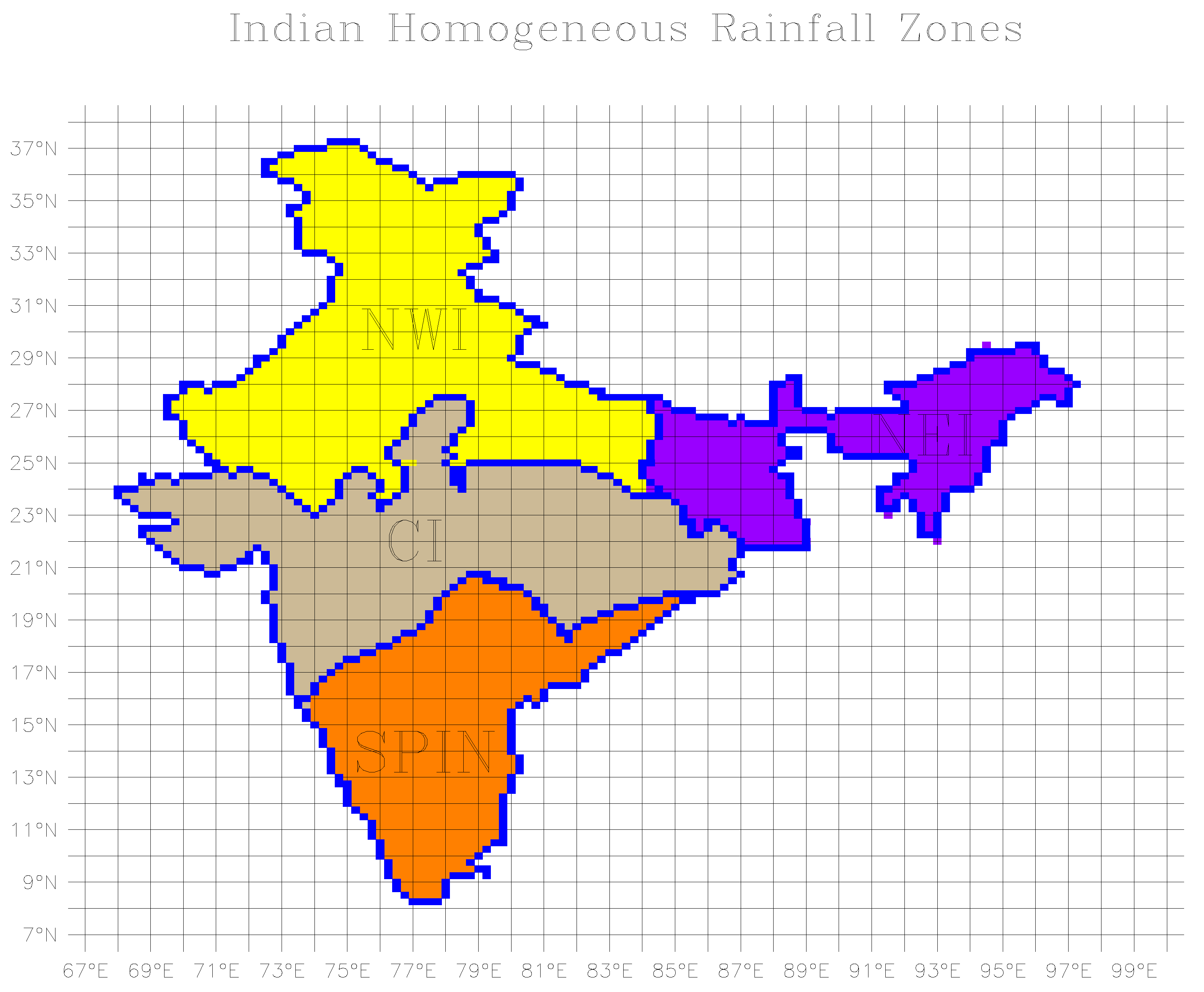
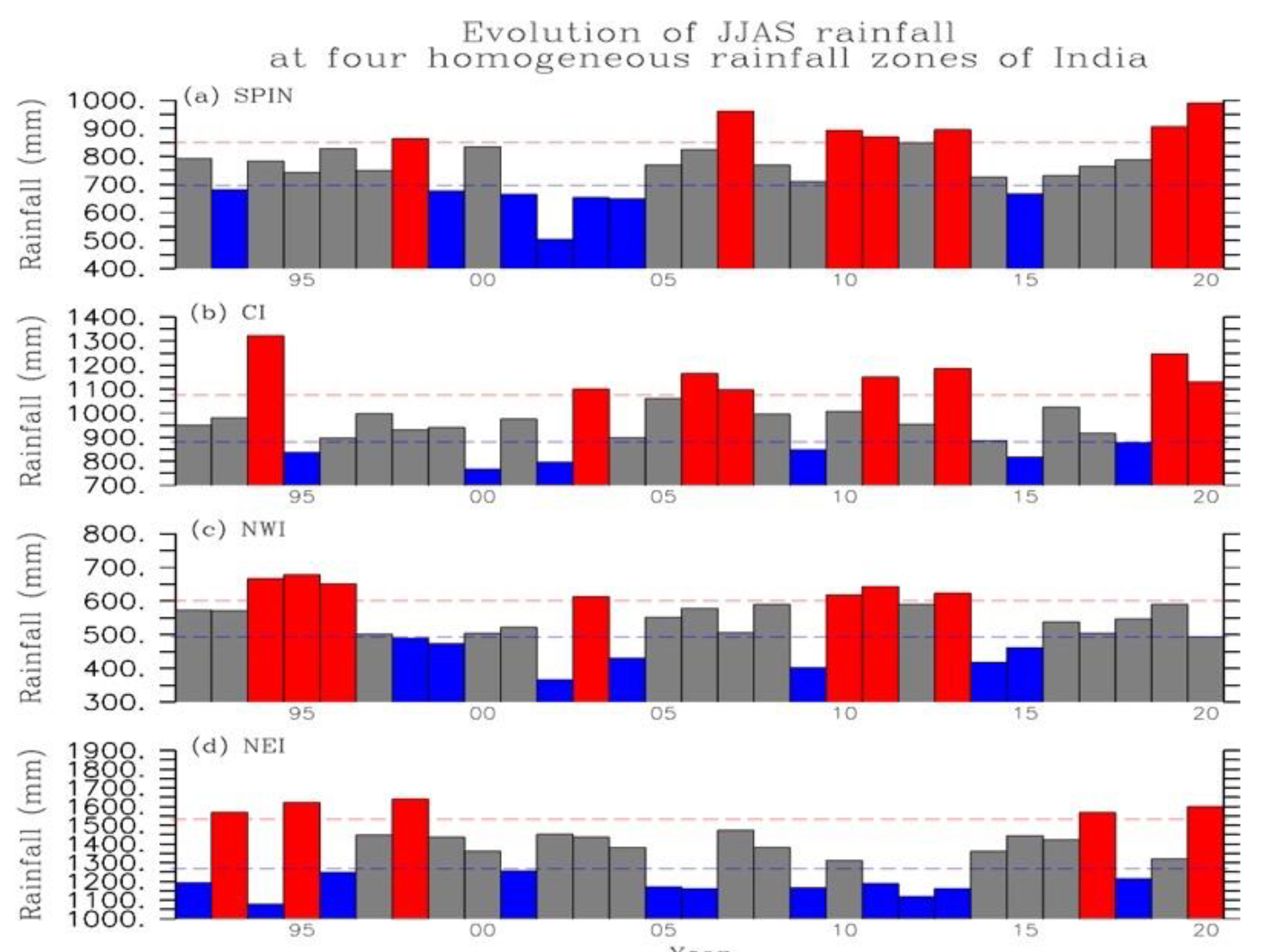
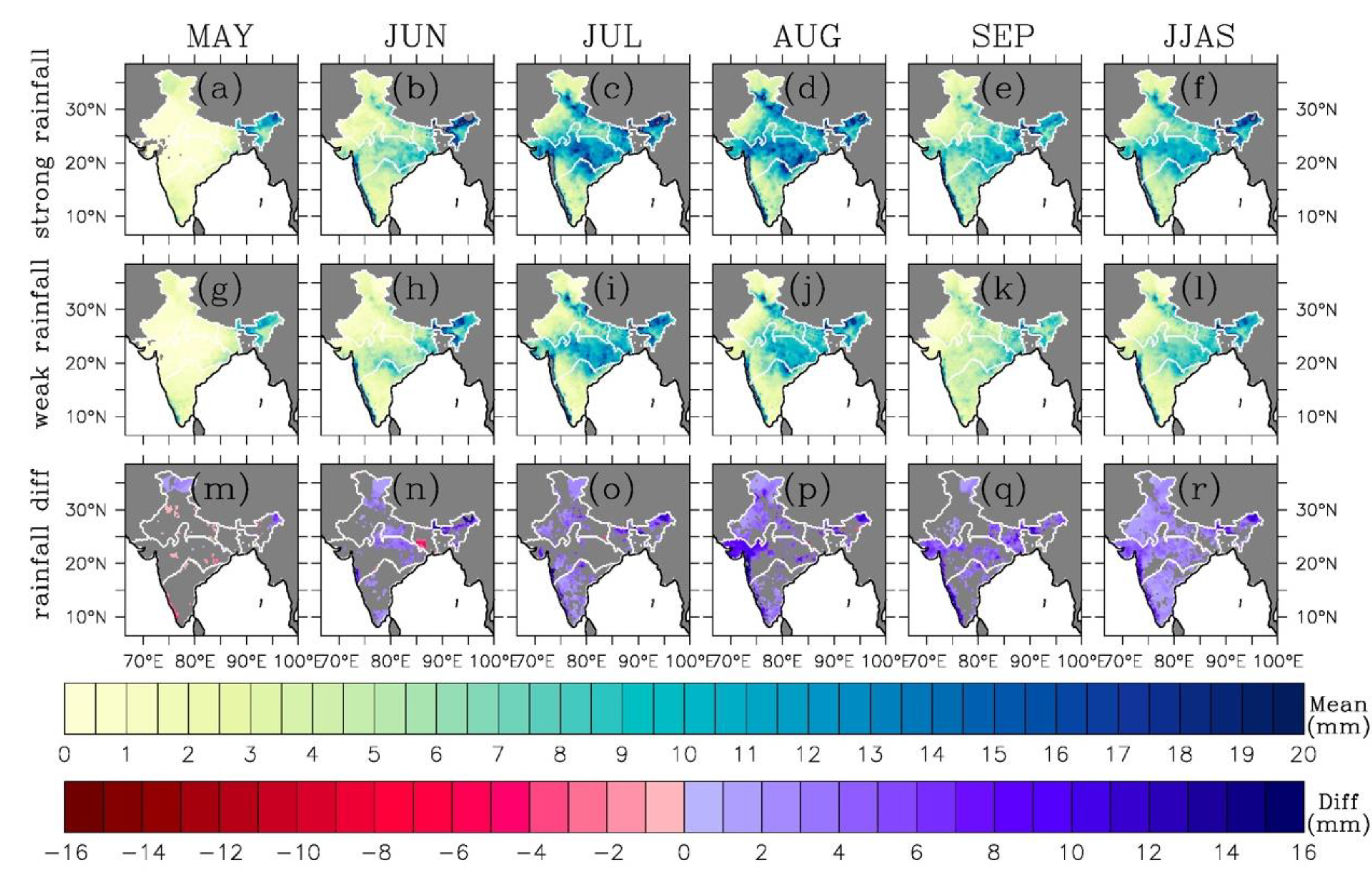
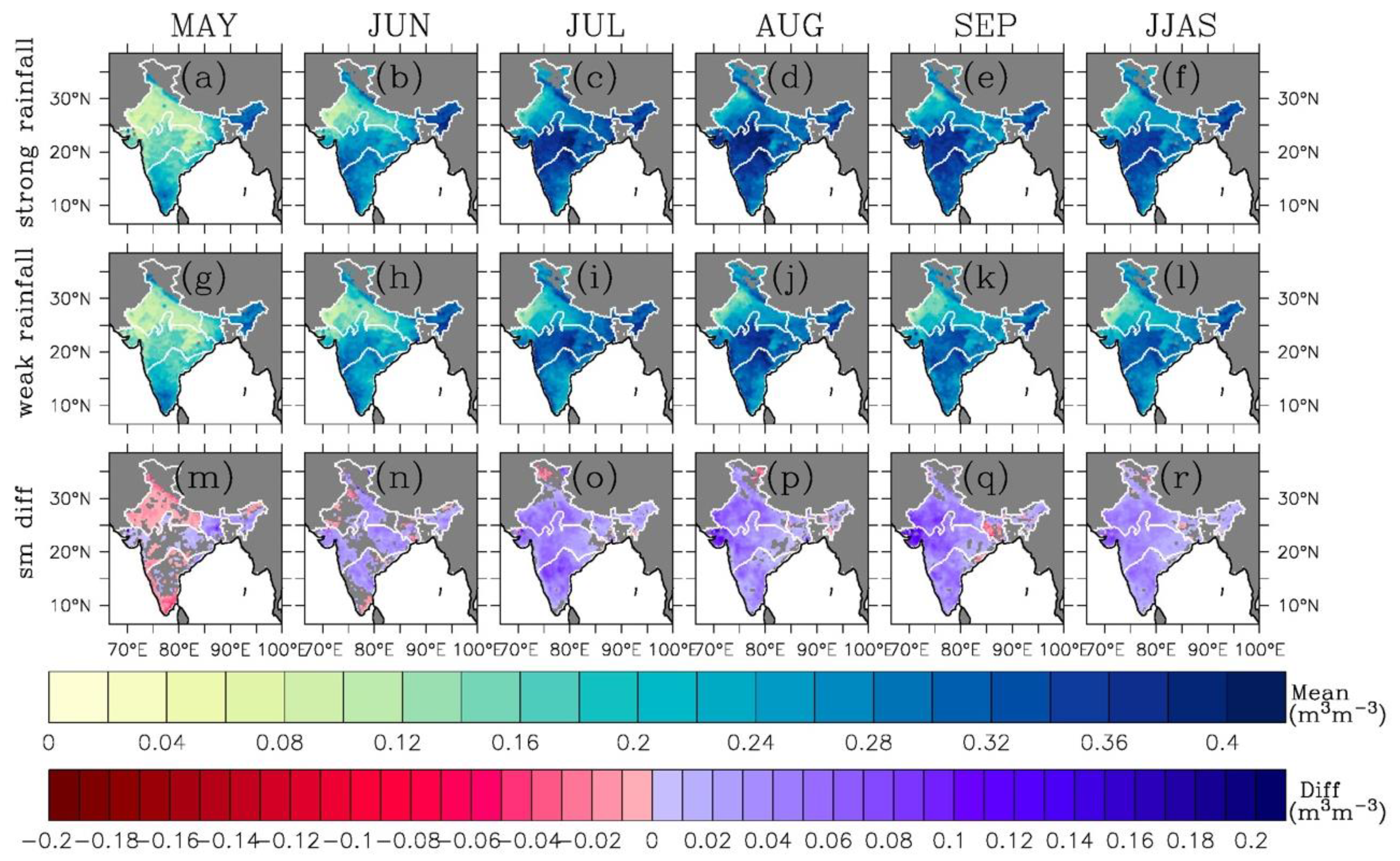
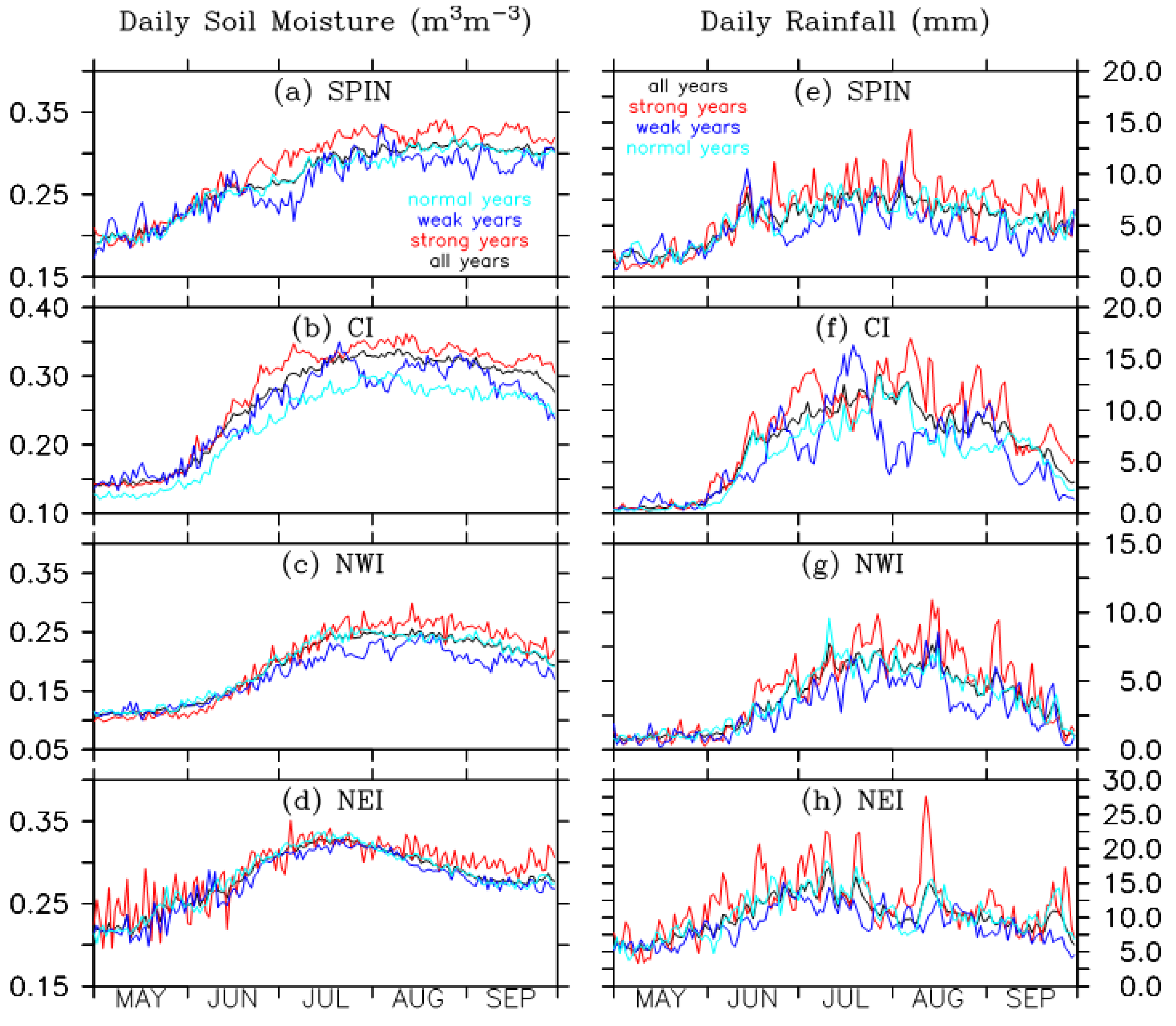
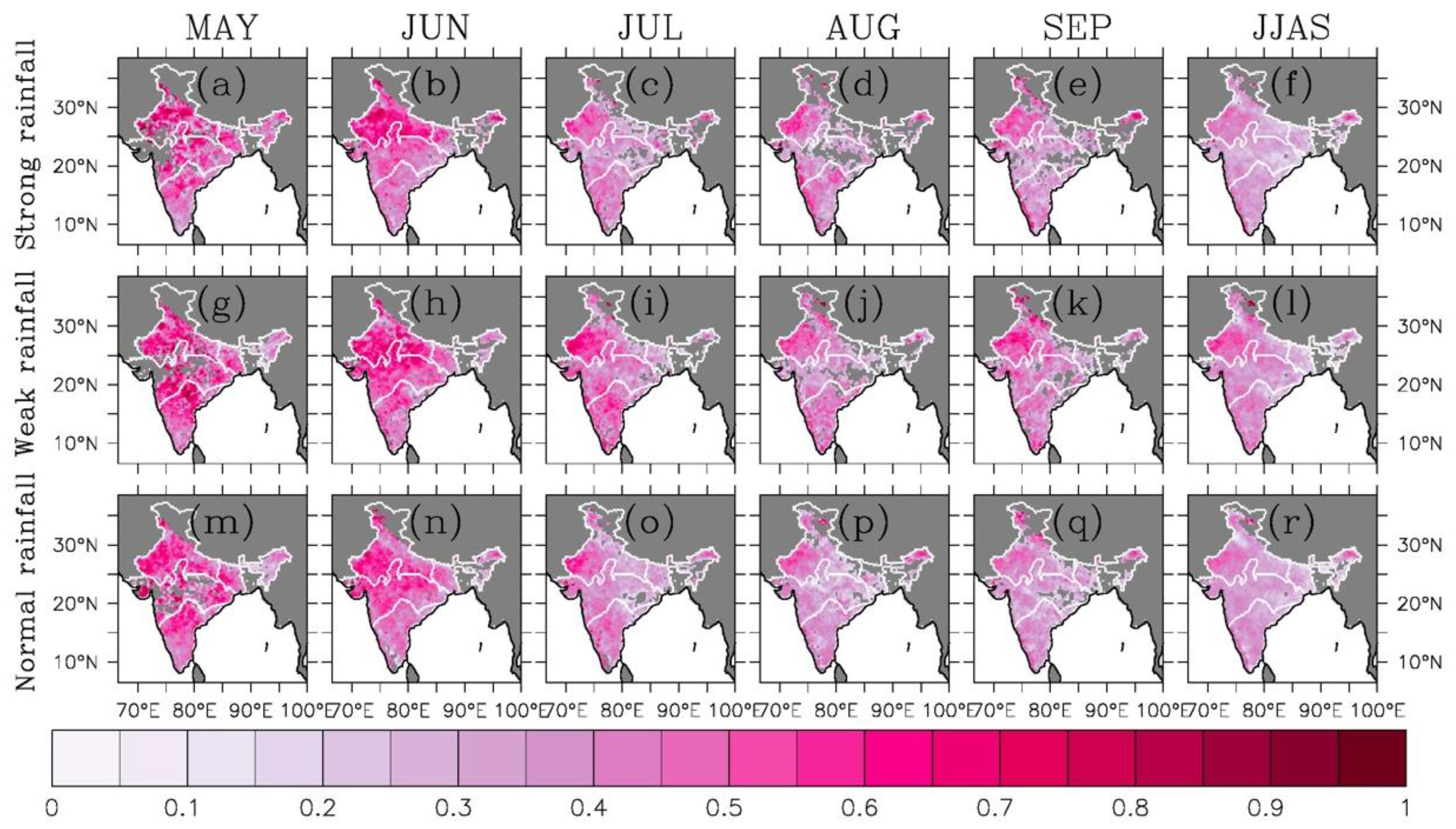
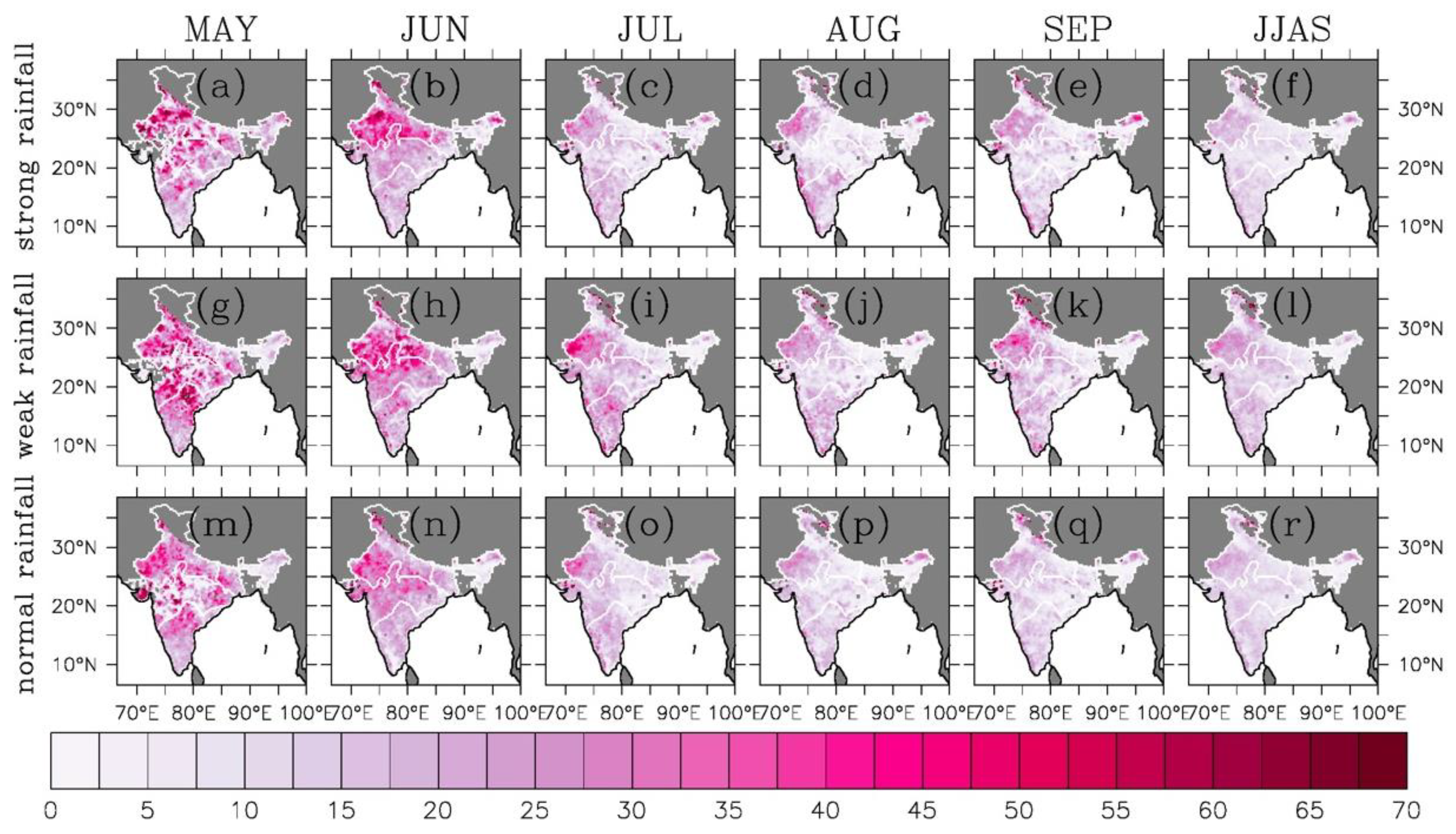
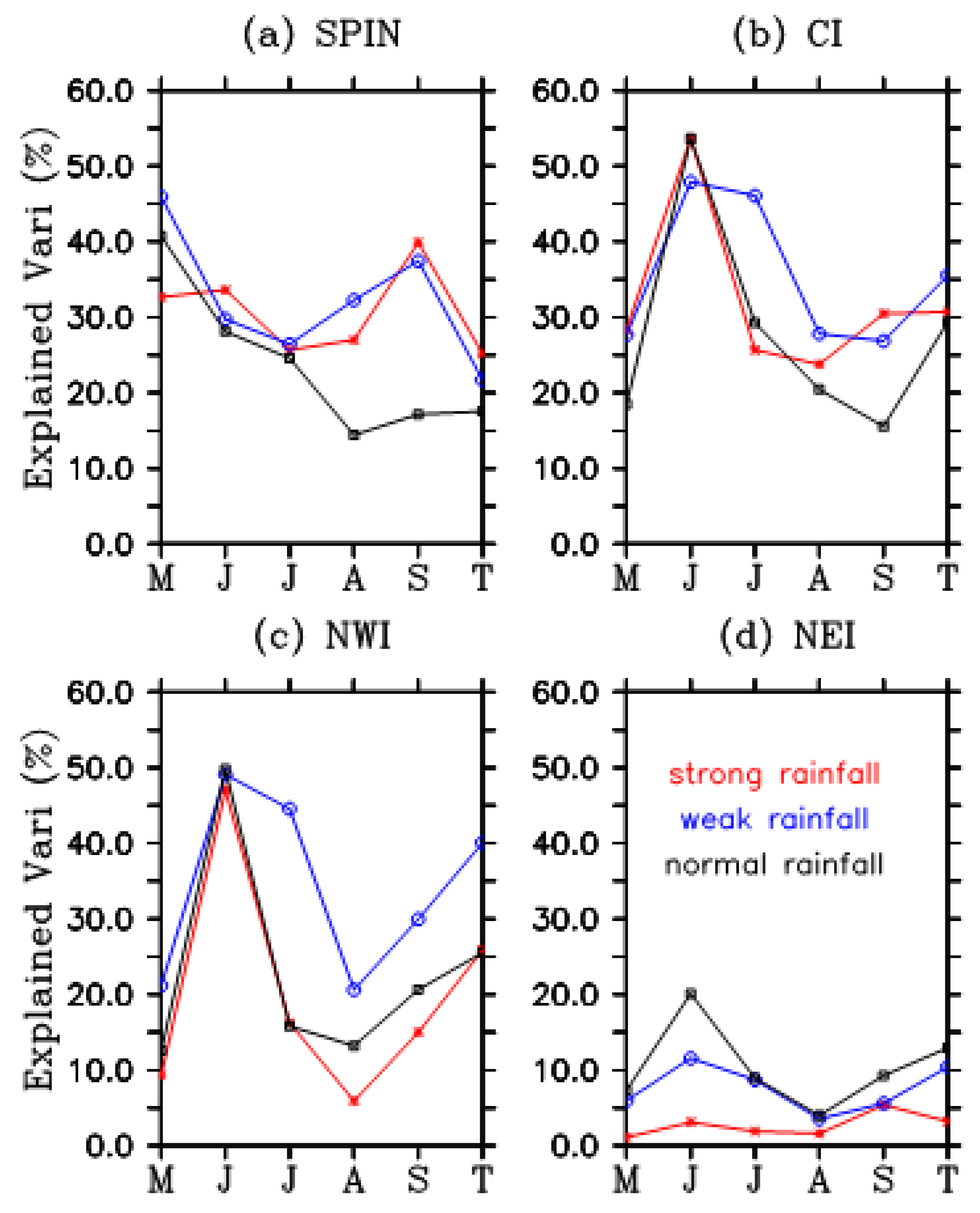
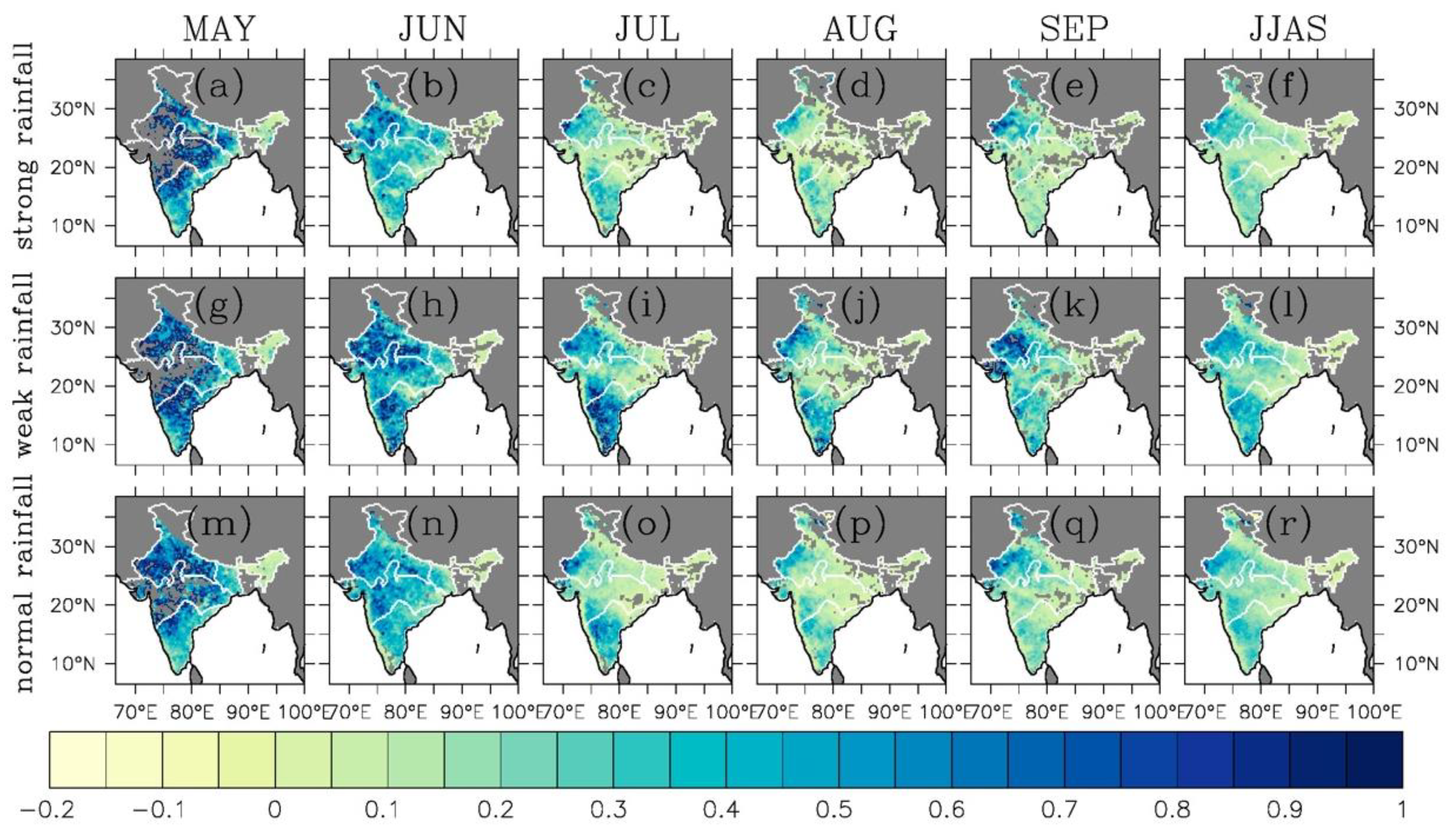
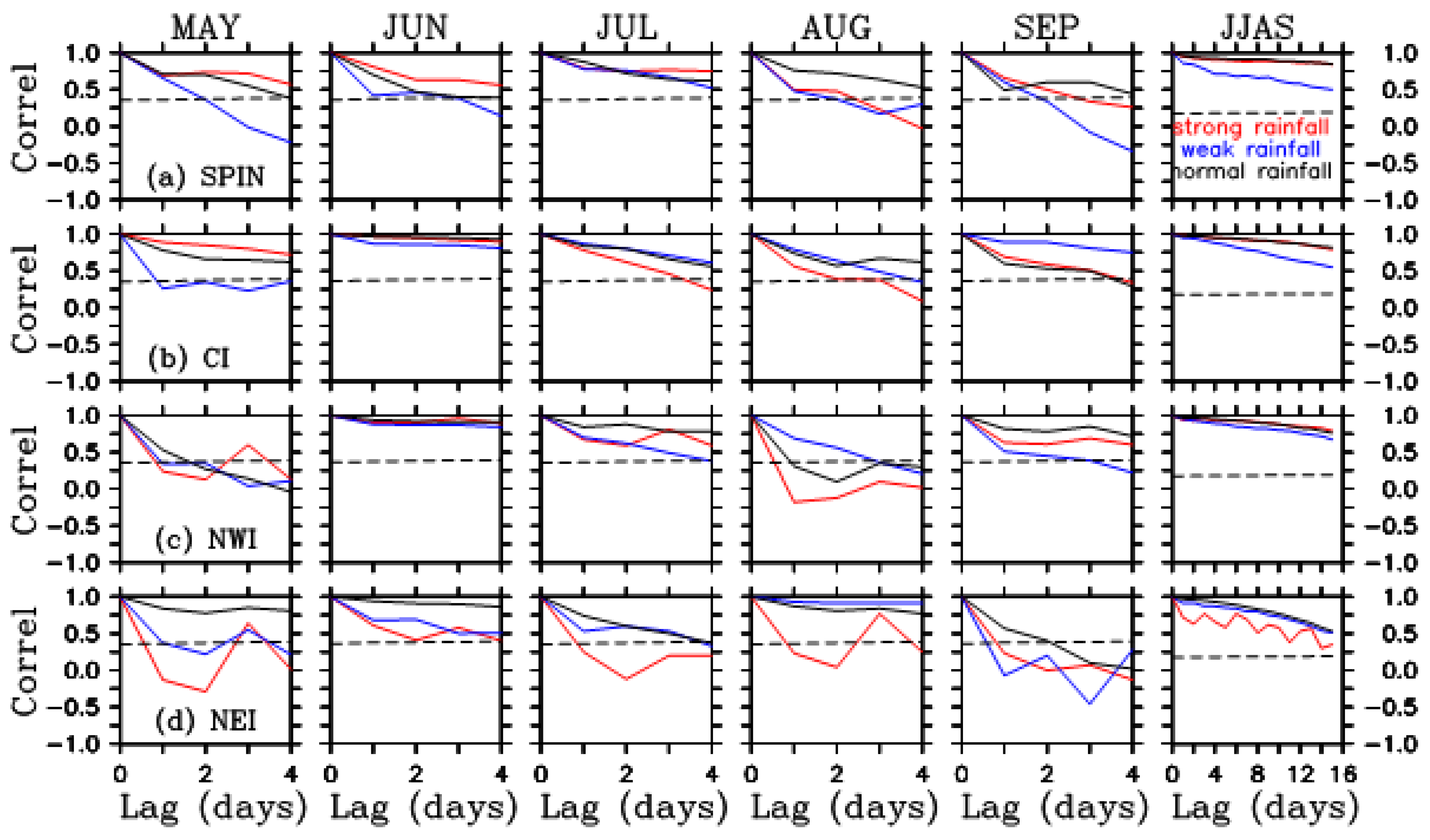
| Location | ISM Strength | Years |
|---|---|---|
| SPIN | Strong | 98, 07, 10, 11, 13, 19, 20 |
| Weak | 93, 99, 01, 02, 03, 04, 15 | |
| Normal | 92, 94, 95, 96, 97, 00, 05, 06, 08, 09, 12, 14, 16, 17, 18 | |
| CI | Strong | 94, 03, 06, 07, 11, 13, 19, 20 |
| Weak | 95, 00, 02, 09, 15, 18 | |
| Normal | 92, 93, 96, 97, 98, 99, 01, 04, 05, 08, 10, 12, 14, 16, 17 | |
| NWI | Strong | 94, 95, 96, 03, 10, 11, 13 |
| Weak | 98, 99, 02, 04, 09, 14, 15 | |
| Normal | 92, 93, 97, 00, 01, 05, 06, 07, 08, 12, 16, 17, 18, 19, 20 | |
| NEI | Strong | 93, 95, 98, 17, 20 |
| Weak | 92, 94, 96, 01, 05, 06, 09, 11, 12, 13,18 | |
| Normal | 97, 99, 00, 02, 03, 04, 07, 08, 10, 14, 15, 16, 19 |
| Location | ISM Strengths | May | Jun | Jul | Aug | Sep | JJAS |
|---|---|---|---|---|---|---|---|
| SPIN | Strong | 0.57 | 0.58 | 0.51 | 0.52 | 0.63 | 0.50 |
| Weak | 0.68 | 0.55 | 0.51 | 0.57 | 0.61 | 0.47 | |
| Normal | 0.64 | 0.53 | 0.50 | 0.38 | 0.41 | 0.42 | |
| CI | Strong | 0.53 | 0.73 | 0.51 | 0.49 | 0.55 | 0.55 |
| Weak | 0.53 | 0.69 | 0.68 | 0.53 | 0.52 | 0.60 | |
| Normal | 0.43 | 0.73 | 0.54 | 0.45 | 0.39 | 0.54 | |
| NWI | Strong | 0.31 | 0.69 | 0.40 | 0.23 | 0.39 | 0.51 |
| Weak | 0.46 | 0.70 | 0.67 | 0.45 | 0.55 | 0.63 | |
| Normal | 0.36 | 0.71 | 0.40 | 0.36 | 0.45 | 0.53 | |
| NEI | Strong | 0.10 | 0.17 | 0.14 | 0.13 | 0.23 | 0.18 |
| Weak | 0.24 | 0.34 | 0.30 | 0.19 | 0.24 | 0.32 | |
| Normal | 0.27 | 0.45 | 0.30 | 0.20 | 0.30 | 0.36 |
Publisher’s Note: MDPI stays neutral with regard to jurisdictional claims in published maps and institutional affiliations. |
© 2022 by the authors. Licensee MDPI, Basel, Switzerland. This article is an open access article distributed under the terms and conditions of the Creative Commons Attribution (CC BY) license (https://creativecommons.org/licenses/by/4.0/).
Share and Cite
Zheng, Y.; Bourassa, M.A.; Ali, M.M. The Impact of Rainfall on Soil Moisture Variability in Four Homogeneous Rainfall Zones of India during Strong, Weak, and Normal Indian Summer Monsoons. Water 2022, 14, 2788. https://doi.org/10.3390/w14182788
Zheng Y, Bourassa MA, Ali MM. The Impact of Rainfall on Soil Moisture Variability in Four Homogeneous Rainfall Zones of India during Strong, Weak, and Normal Indian Summer Monsoons. Water. 2022; 14(18):2788. https://doi.org/10.3390/w14182788
Chicago/Turabian StyleZheng, Yangxing, Mark A. Bourassa, and M. M. Ali. 2022. "The Impact of Rainfall on Soil Moisture Variability in Four Homogeneous Rainfall Zones of India during Strong, Weak, and Normal Indian Summer Monsoons" Water 14, no. 18: 2788. https://doi.org/10.3390/w14182788








